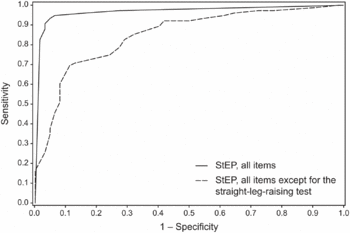Straight leg raise
The Straight leg raise also, called Lasègue sign or Lasègue test, is a test done during the physical examination to determine whether a patient with low back pain has an underlying herniated disk.
Technique
With the patient laying down on a table, the examiner lifts the patient's leg while the knee is straight.
Variations
If the examiner also dorsiflexes the foot, this is the Lasègue sign.
Another variation is to lift the leg while the patient is sitting.[1] However, in one study this reduces the sensitivity of the test from 67% to 41%.[2]
Another variation in the sitting position is the flip test.[3] In this maneuver, the patient is asked to sit erect, without slumping.
Another variation in the sitting position is the slump test.[4] In the Slump test:
- the patient sits looking straight ahead
- then is encouraged to slump in order to flex the thoracic and lumbar spines
- then fully flex the cervical spine, continuing to look straight ahead
- then the patient extends the leg at the knee
- then the examiner dorsiflexes the foot
In one study, the sensitivity of the Slump test was 84% and specificity was 83% while the [sensitivity and specificity|sensitivity]] of the SLR test was 52% with specificity of 89%.[4]
Interpretation
| Finding | Sensitivity | Specificity |
|---|---|---|
| Straight leg raise | 92%[5] to 80%[6] | 28%[5] to 40%[6] |
| Crossed straight leg raise | 28%[5] | 95%[5] |
"The straight leg raise test is positive if pain in the sciatic distribution is reproduced between 30° and 70° passive flexion of the straight leg." [7]
If pain below the knee only occurs below the knee after more than 70°, this may indicate "sciatic nerve compression outside the spinal canal."[4]

References
- ↑ Waddell G, McCulloch JA, Kummel E, Venner RM (1980). "Nonorganic physical signs in low-back pain". Spine 5 (2): 117-25. PMID 6446157. [e]
- ↑ Rabin A, Gerszten PC, Karausky P, Bunker CH, Potter DM, Welch WC (2007). "The sensitivity of the seated straight-leg raise test compared with the supine straight-leg raise test in patients presenting with magnetic resonance imaging evidence of lumbar nerve root compression". Archives of physical medicine and rehabilitation 88 (7): 840-3. DOI:10.1016/j.apmr.2007.04.016. PMID 17601462. Research Blogging.
- ↑ Summers B, Mishra V, Jones JM (2009). "The flip test: a reappraisal.". Spine (Phila Pa 1976) 34 (15): 1585-9. DOI:10.1097/BRS.0b013e3181aa1bf0. PMID 19564769. Research Blogging.
- ↑ 4.0 4.1 4.2 Majlesi J, Togay H, Unalan H, Toprak S (April 2008). "The sensitivity and specificity of the Slump and the Straight Leg Raising tests in patients with lumbar disc herniation". J Clin Rheumatol 14 (2): 87–91. DOI:10.1097/RHU.0b013e31816b2f99. PMID 18391677. Research Blogging.
- ↑ 5.0 5.1 5.2 5.3 5.4 van der Windt DA, Simons E, Riphagen II, Ammendolia C, Verhagen AP, Laslett M et al. (2010). "Physical examination for lumbar radiculopathy due to disc herniation in patients with low-back pain.". Cochrane Database Syst Rev 2: CD007431. DOI:10.1002/14651858.CD007431.pub2. PMID 20166095. Research Blogging.
- ↑ 6.0 6.1 6.2 Deyo RA, Rainville J, Kent DL (1992). "What can the history and physical examination tell us about low back pain?". JAMA 268 (6): 760–5. PMID 1386391. [e]
- ↑ Speed C (2004). "Low back pain". BMJ 328 (7448): 1119-21. DOI:10.1136/bmj.328.7448.1119. PMID 15130982. Research Blogging.